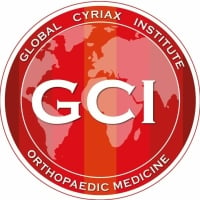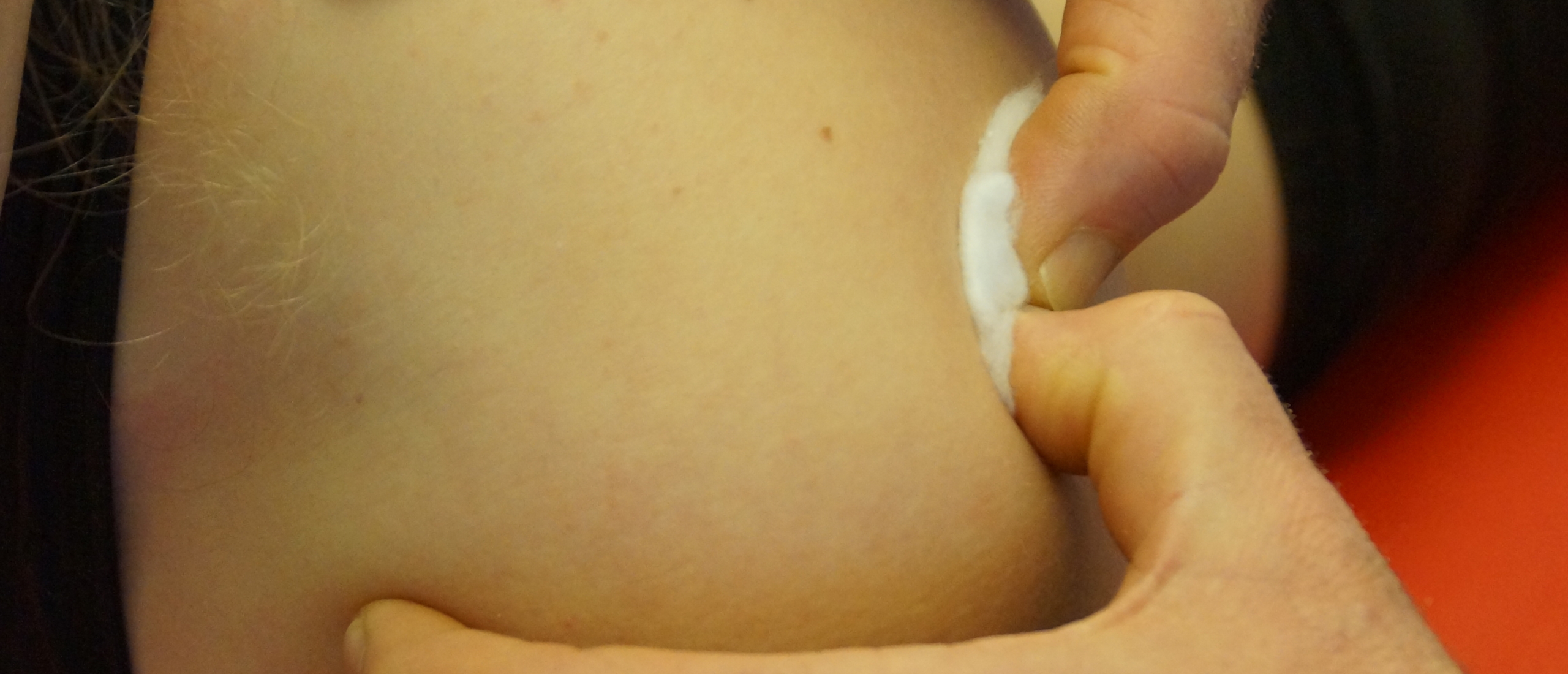
Cross friction massage for tendinopathy
Cross friction massage for tendinopathy?
As pointed out before , cross friction massage could provide a useful additional value in our treatment strategy of tendinopathy. Of course, this is part of an overall loading and exercise strategy, which has to be adapted to the specific stage of the lesion.
A good clinical reasoning strategy and functional examination will enable us to reach a more specific diagnosis when it comes to tendinopathy.
How can I palpate / find the correct localisation?
How can I find the insertion or the musculotendinous junction of the supraspinatus and the infraspinatus ? The cranial or the caudal part of the subscapularis insertion or the biceps tendon in the bicepital groove ?
In the film I show you in detail how to palpate or to perform cross friction massage on those structures.
A good palpation technique is also important when you apply other treatment methods such as e.g. shock wave therapy or dry needling. It will help you go more “to the point”.
It's not only about treatment techniques ; don't underestimate the importance of relevant clinical reasoning procedures. During the Mastermind private training in orthopaedic medicine Cyriax we focus entirely on what you really need in clinical practice to increase your therapeutic and diagnostic efficiency.
Cross friction massage supraspinatus, tenoperiosteal
 Cross friction massage supraspinatus tenoperiosteal
Cross friction massage supraspinatus tenoperiosteal
The patient sits with his arm behind the back (medial rotation makes the insertion of the tendon, now lying in front of the acromion, accessible to the finger). We can palpate the spine of the scapula in a lateral direction ; as soon as we lose contact with the bone, we come back onto the bone and palpate now in an anterior direction. We know for sure that we are on the acromion. The tendon (with its insertion on the greater tuberosity) is found just beyond the anterior edge of the acromion.
For a left shoulder, it is easier to palpate with the left hand.
The deep friction is done in the normal way, with the index finger of the homolateral hand, reinforced by the middle finger. The thumb should be put quite far down the arm. So that a downward pressure is exerted on the greater tuberosity, the index finger-nail remaining horizontal.
Don’t put the thumb posteriorly, with the nail of the index finger pointing anteriorly ; in that case a pressure would be exerted to the front of the acromion and not on the supraspinatus. This is a rather frequent error.
Cross friction massage infraspinatus, tenoperiosteal
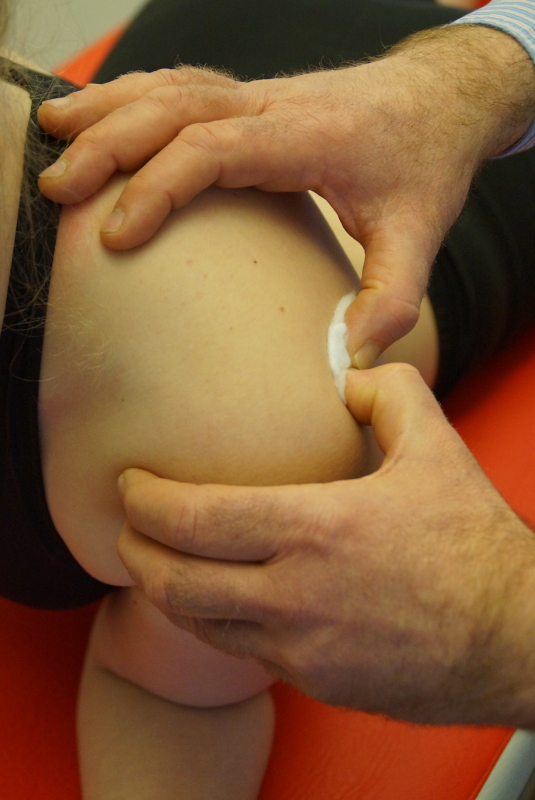 Infraspinatus transverse friction massage, tenoperiosteal
Infraspinatus transverse friction massage, tenoperiosteal
The patient lies in the sphinx position : prone lying, 90° of elbow flexion, with the shoulder in slight lateral rotation and adduction. This is the best, but not always the most comfortable position (e.g. elderly patients or some back patients). For that reason we use an alternative position in side-lying, where the same components as in the sphinx position can be built in.
Technique : the palpation, in view of finding the precise localization, is a supination movement with flexed thumb, preferably performed with both hands simultaneously. In this way, when palpating in a lateral direction under the spine of the scapula, the
difference between muscle belly (soft), tendinous body (cable), insertion (cable and bone) and beyond the insertion (bone without cable) can clearly be felt.
The deep friction itself is taking a reserve of skin in a pronation direction first, then applying pressure and performing the active phase of the movement, which is a supination. Make sure it is a wrist movement and not just a finger movement. Since the skin in this area is much vulnerable, a thin layer of cotton-wool is used between the patient’s skin and our thumb.
It is best to perform this technique with both hands, whereby one thumb reinforces the other.
Cross friction massage biceps, sulcus
Palpation : see technique for the subscapular tendon.
With the patient’s arm in lateral rotation, the heterolateral thumb is put longitudinally into the groove and pressure is exerted sideways. The active phase of the deep friction is a medial rotation with the other arm.
Remark : the groove can easily be felt, but the tendon is not always felt (depends probably on the height of the bony edges of the groove).
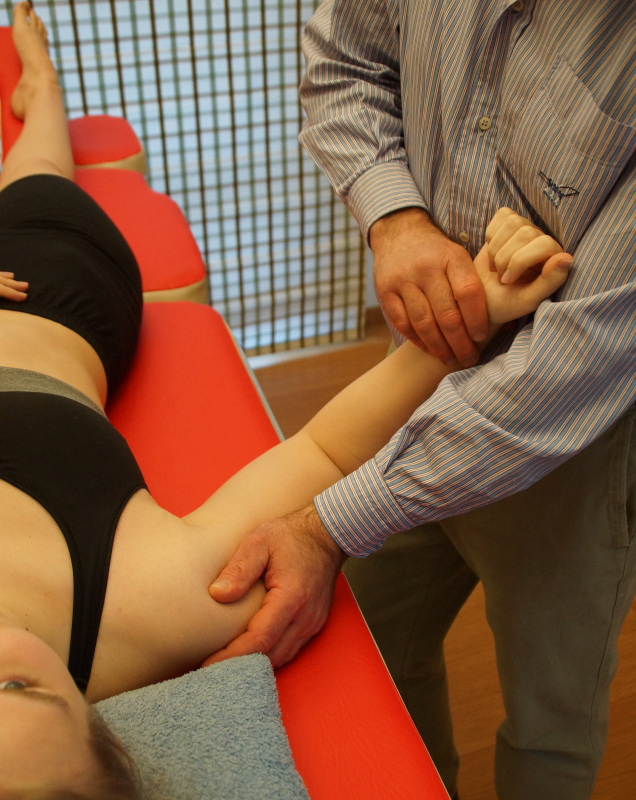 Cross friction massage biceps
Cross friction massage biceps
Cross friction massage subscapularis, tenoperiosteal
Palpation : for a left subscapularis, we palpate with the right thumb under the clavicle in a lateral direction ; we reach the coracoid process. We move downwards and laterally again till we feel the lesser tuberosity (check : laterally to this bone we find the bicipital groove). Back to the lesser tuberosity, thumb in a 45° distal and medial direction ; large movement of the thumb forwards (taking the skin with us) and back to the lesser tuberosity with the thumb well flexed (this might be a painful phase).
We feel one or two tendons slip under our thumb (short head of biceps and coracobrachialis) and, if we keep our thumb flexed, we do not lose the anterior edge of the deltoid muscle. Now we bring our thumb in a longitudinal direction for the deep friction.
This will be a large rolling movement of the arm upwards, with the thumb as flat as possible , for the patient’s comfort. However, a slight degree of flexion is permanently needed, in order to keep the edge of deltoid behind our thumb during the entire friction. So we cannot release the pressure completely on the way back as in a normal deep friction. Stand lateral to the patient during the DTM.
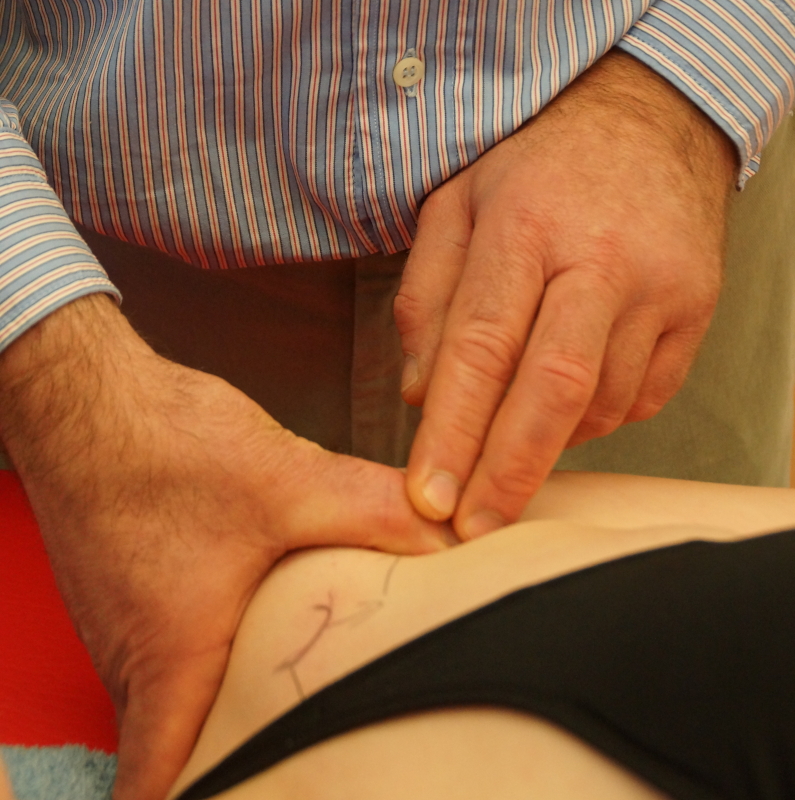 Cross friction massage subscapularis
Cross friction massage subscapularis
